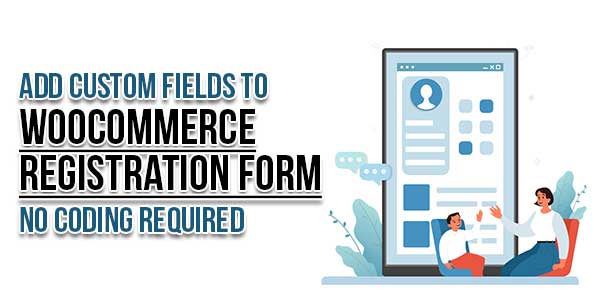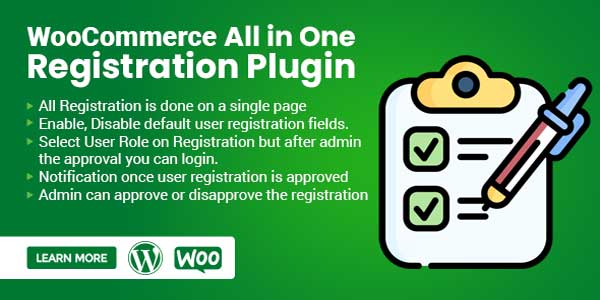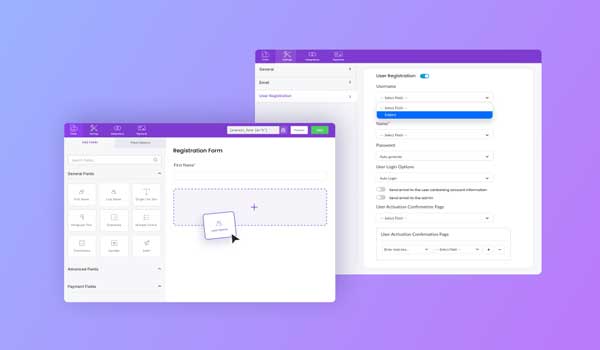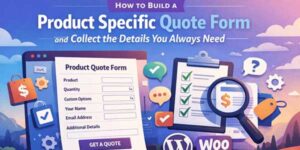
Picture this. A customer lands on your store. They’re ready to sign up. What do they see? Just an email and a password box. Boring. Too plain. Not enough. You want more. Maybe you want their phone. Maybe their company name. Or even their birthday. But then you stop. Wait coding? Templates? Developers? Nah, too much headache.
Here’s the truth: you don’t need coding. Zero. Nada. With a few smart tools, you can add custom fields to your WooCommerce registration form in minutes. Click. Done. Customers give you exactly the info you need. And you look like a pro.
Table of Contents
Why Add Custom Fields in WooCommerce?
The default WooCommerce form is basic. Really basic. It’s fine for hobby stores. Not for serious business. You want to know your customers better, right? A B2B shop might need a tax ID. A clothing shop might need size preferences. A service site might require a city or a country. Without these fields, you’re flying blind.
Adding custom fields is like putting on glasses. Suddenly, you see clearly. Customers feel valued. You collect real data. And you make smarter decisions later.
Old Way vs. New Way:
Let’s be honest. The old way sucked. Editing PHP. Copying template files. One small mistake—boom, white screen. Or worse, your checkout breaks. Hiring a dev? Expensive. And updates wipe out your edits.
The new way? Simple. Plugins. Point. Click. Save. No fear. No broken site. That’s the beauty of it. You stay in control.
Benefits Of No-Code Solutions:
- Fast. Add a field in under 2 minutes.
- Flexible. Change whenever you want.
- Easy. No “developer mode” needed.
- Safe. Works with WooCommerce updates.
- Scales. Big shop, small shop—it adapts.
Why make life hard when it can be this easy?
What Kind Of Fields Can You Add?
It’s not just text boxes. You’ve got options—lots of them.
- Text input → for phone, company, or ID.
- Dropdown → choose country, role, or category.
- Checkbox → agree to terms, newsletters.
- Radio buttons → quick choices like “Retailer / Wholesaler.”
- File upload → ID card, resume, logo.
- Date picker → birthdays, delivery dates.
It’s like building Lego. Pick what you need. Snap it in place.
Use Cases: Different Stores, Different Needs
Every store tells a story. Custom fields help you write yours.
- Wholesale shop → Need company name + VAT number. You don’t want random shoppers sneaking into wholesale pricing.
- Membership site → Add “Membership Type.” Students, pros, or enterprises. Different paths for each.
- Event site → Collect “Preferred Event Date.” Saves back-and-forth emails.
- Gift shop → Birthday field. Surprise them later with a discount.
- Job board → File upload. Simple “Upload Resume” field. Done.
One form. Many possibilities.
How Plugins Do The Magic?
Here’s the process. No code. Just clicks.
- Install the plugin.
- Go to settings.
- Add field. Choose type.
- Label it. Example: “Phone Number.”
- Mark it required.
And boom. It’s live on your registration page. The customer fills it. Data saved in profile. Done. That’s simple.
Plugins That Make It Happen:

1.) User Registration for WooCommerce:
Think of this as an all-in-one. Default fields? Yes. Role selection? Yes. Approvals? Yes. You decide who joins, who waits. Super handy for wholesale shops.
2.) WooCommerce Registration Fields Plugin:
Straightforward. Pure custom fields. Unlimited. Drop them where you want. Beginner-friendly.
3.) User Registration by WP Everest:
Drag. Drop. Build. Full form builder. Not just fields, but entire designs. Perfect for full control freaks.
4.) Profile Builder Pro:
Covers WooCommerce and more. Custom fields, custom profiles, and role management. Ideal for membership sites. Each plugin fits a different story. Choose based on what your store needs.
Adding A Phone Field:
You run a small boutique. Customers sign up. You realise you can’t contact them quickly. Email is too slow. You need phone numbers.
You grab a plugin. Add a field. “Phone Number.” Mark it required. Done. Next registration? Customer fills in their number. You now have faster contact. No coding. No stress.
That’s the power of simple changes.
Roles At Registration:
Here’s a cool trick. Let users pick roles when signing up. For example:
- Customer.
- Wholesaler.
- Vendor.
You show a dropdown. They choose. You approve. Or not. That’s control. That’s how you separate casual buyers from serious business clients.
Emails & Notifications:
Don’t leave customers hanging. With plugins, emails are automated. And customizable.
- “Thanks for signing up. Pending approval.”
- “Congrats, you’re approved.”
- “Sorry, your account was rejected.”
Professional. Smooth. Builds trust. Customers love clarity.
Spam Control:
Spammers love open forms. You can fight back. Add extra fields—force approval. Add checkboxes. Make them work harder. Real users won’t mind. Bots will quit.
Result? Clean database. No junk signups.
Using the Data You Collect:
This is where the fun begins. That data you collect? Use it.
- Segment emails by role.
- Export birthdays. Send offers.
- Filter by city for local events.
- Show info on invoices.
You don’t just collect info. You use it to grow sales.
Mistakes to Avoid:
- Adding too many fields. Nobody likes long forms.
- Making everything mandatory. People quit.
- Forgetting to test on mobile. Half your users shop there.
- Ignoring privacy laws. Data protection matters.
Less is more. Always.
Best Practices:
- Keep it short. 3–5 extra fields.
- Use dropdowns, not free text. Faster for users.
- Personalize emails.
- Test forms regularly.
It’s about balance. Ask only what matters.
Advanced Tricks:
Some plugins let you go further:
- Conditional logic. (If the user selects “Business,” show the VAT field.)
- Multi-step forms. Break it down.
- File uploads. For verification.
- CRM integration. Data flows straight to your system.
This is where simple forms turn into business engines.
Real Example: Wholesale Store
Imagine you sell bulk electronics. You don’t want every random shopper in. So you:
- Add “Company Name.”
- Add “Tax ID.”
- Add a dropdown for “Retailer/Wholesaler.”
- Set wholesaler role to “Pending.”
Legit businesses get approved. Shoppers stay retail. You protect pricing. Everyone’s happy.
Real Example: Learning Platform
You launch an online course site. Students and teachers sign up. But you need to know who’s who. So, you:
- Add “Role” dropdown.
- Add “Institution.”
- Send custom emails to each role.
Teachers get different dashboards. Students see learning content. It feels tailored. Because it is.
Marketing & SEO Benefits
Sounds weird. But forms affect SEO. How?
- Better data → Better segmentation.
- Better segmentation → More engagement.
- More engagement → More sales.
- More sales → Better site metrics.
- Better metrics → Google smiles.
It’s a chain reaction.
Bonus: Flexible Pricing
Sometimes fields are about more than info. They create freedom. Example: WooCommerce Name Your Price. Customers enter what they want to pay. Pair that with custom fields, and you’ve got powerful flexibility. Great for donations, tips, or creative products.
Quick Checklist Before Launch:
- Install the plugin.
- Add fields wisely.
- Test everything.
- Customize emails.
- Approve test accounts.
That’s it. Your store’s ready.
Conclusion:
The default WooCommerce form is too basic. If you want real growth, you need custom fields. And thanks to plugins, you can add them with zero coding. It’s faster, safer, and smarter.
Think of it this way. Your registration form is the front door to your shop. Why leave it plain? Make it welcoming. Make it useful. Collect the info you need. Protect your store. And give customers a smoother experience.
No development. No code. Just you, your store, and smarter tools. That’s the future.

 About the Author:
About the Author:












Be the first to write a comment.